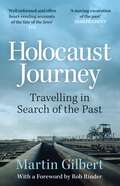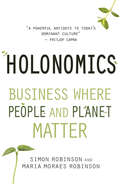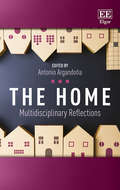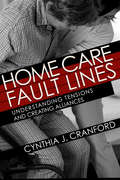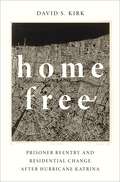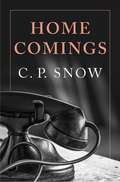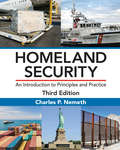- Table View
- List View
Holocaust Journey: Travelling In Search Of The Past
by Sir Martin GilbertIncludes a new foreword by Rob RinderWhat readers are saying about HOLOCAUST JOURNEY:'Brilliant ... A must read for everybody' ⭐⭐⭐⭐⭐'Devastating' ⭐⭐⭐⭐⭐'Fascinating, thought provoking and shocking' ⭐⭐⭐⭐⭐'Everybody should read this' ⭐⭐⭐⭐⭐'Informative and emotional' ⭐⭐⭐⭐⭐In June 1996 Martin Gilbert took a group of students on a two-week journey across middle-Europe which encompassed all the major places in the Holocaust - from Wannsee where the extermination of the Jews was decreed, to the camps themselves, via deserted Jewish communities and synagogues as well as the sites of the ghettos and deportation.'The achievement of Gilbert's HOLOCAUST JOURNEY is to reduce to comprehensible, human terms of the scale of the genocide that to many is still unimaginable' LITERARY REVIEW'Filled with short, well-informed and often heart-rending accounts of the fate of the Jews' TLS'HOLOCAUST JOURNEY travels along the tracks of a history we would rather forget to the sites of wartime horror, and is also a moving excavation of the past' INDEPENDENT
Holocaust Monuments and National Memory: France and Germany since 1989
by Peter CarrierSince 1989, two sites of memory with respect to the deportation and persecution of Jews in France and Germany during the Second World War have received intense public attention: the Vélo d'Hiver (Winter Velodrome) in Paris and the Monument for the Murdered Jews of Europe or Holocaust Monument in Berlin. Why is this so? Both monuments, the author argues, are unique in the history of memorial projects. Although they are genuine "sites of memory", neither monument celebrates history, but rather serve as platforms for the deliberation, negotiation and promotion of social consensus over the memorial status of war crimes in France and Germany. The debates over these monuments indicate that it is the communication among members of the public via the mass media, rather than qualities inherent in the sites themselves, which transformed these sites into symbols beyond traditional conceptions of heritage and patriotism.
Holonomi: Business Where People and Planet Matter
by Simon RobinsonBusinesses around the world are facing rapidly changing economic and social situations. Business leaders and managers must be ready to respond and adapt in new, innovative ways. The authors of this groundbreaking book argue that business people must adopt a 'holonomic' way of thinking, a dynamic and authentic understanding of the relationships within a business system, and an appreciation of the whole. Complexity and chaos are not to be feared, but rather are the foundation of successful business structures and economi. Holonomi presents a new world view where economi and ecology are in harmony. Using real-world case studies and practical exercises, the authors guide the reader in a new, holistic approach to business, towards a more sustainable future where both people and planet matter.
Holy Living: The Christian Tradition for Today
by The Right Reverend and Right Honourable Lord Williams of Oystermouth Rowan WilliamsApart from being a scholar and theologian, Rowan Williams has also demonstrated a rare gift for speaking and writing plainly and clearly about essentials of the Christian faith. In the chapters of this book he writes with profound perception about the life of holiness to which we are called. The range of Williams' frame of reference is astonishing – he brings poets and theologians to his aid, he writes about the Rule of St Benedict, the Bible, Icons, contemplation, St Teresa of Avila and even R. D. Laing. He concludes with two chapters on the injunction 'Know Thyself' in a Christian context. Throughout, Williams points out that holiness is a state of being – it is he writes 'completely undemonstrative and lacking any system of expertise. It can never be dissected and analysed.'
Holy Living: The Christian Tradition for Today
by Rowan WilliamsApart from being a scholar and theologian, Rowan Williams has also demonstrated a rare gift for speaking and writing plainly and clearly about essentials of the Christian faith. In the chapters of this book he writes with profound perception about the life of holiness to which we are called. The range of Williams' frame of reference is astonishing – he brings poets and theologians to his aid, he writes about the Rule of St Benedict, the Bible, Icons, contemplation, St Teresa of Avila and even R. D. Laing. He concludes with two chapters on the injunction 'Know Thyself' in a Christian context. Throughout, Williams points out that holiness is a state of being – it is he writes 'completely undemonstrative and lacking any system of expertise. It can never be dissected and analysed.'
Holy Places of Jerusalem in Middle East Peace Agreements: The Conflict Between Global and State Identities
by Enrico MolinaroThroughout history Jerusalem and its Holy Places have witnessed fierce religious controversy and political dispute. This multidisciplinary study analyses an international and diplomatic perspective which highlights the state/national (territorial) versus global/transnational approach to Jerusalem with respect to possession and the right to worship. It provides an overview and interpretation of the relevant provisions included in the international documents used in the Middle East Peace Process, and researches the historical complexities of the terms "Status Quo" and "Holy Places" -- terminology crucial to the various claims. Enrico Molinaro sets out to answer the following questions: (1) Under what conditions and to what extent does international law regulate and protect the interests of the various recognised communities in the Holy Places? And (2) What types of collective identities and which representative communities are entitled to raise claims on these places? Various communities have raised fierce controversies over worship rights, such as the Holy Sepulchre inter-Christian disputes and the Har Ha Bait/Haram Al Sharif (Temple Mount/Noble Sanctuary) Israeli-Jewish/Palestinian-Muslim disputes. According to the state/territorial perspective, the relevant groups with respect to possession and worship would be the Israelis and the Palestinians, whereas according to the global/transnational interpretation, such groups should be labelled as Jews, Christians, and Muslims. In the state/territorial perspective, the symbolic value of Jerusalem and its Holy Places is related to the development of the conflicting national Israeli and Arab -- later Palestinian -- collective identities. But in the global perspective, millions of people identify themselves as Jews, Christians, and Muslims. These people, who are mostly living outside of Jerusalem and the Israeli-Palestinian areas, consider the city and its Holy Places to be a locus for worship and spiritual devotion. This book is essential reading for all those involved in studying International Legal Agreements and for all Middle East Studies practitioners.
The Holy Roman Empire: A Short History
by Barbara Stollberg-Rilinger Yair MintzkerA new interpretation of the Holy Roman Empire that reveals why it was not a failed state as many historians believeThe Holy Roman Empire emerged in the Middle Ages as a loosely integrated union of German states and city-states under the supreme rule of an emperor. Around 1500, it took on a more formal structure with the establishment of powerful institutions—such as the Reichstag and Imperial Chamber Court—that would endure more or less intact until the empire's dissolution by Napoleon in 1806. Barbara Stollberg-Rilinger provides a concise history of the Holy Roman Empire, presenting an entirely new interpretation of the empire's political culture and remarkably durable institutions.Rather than comparing the empire to modern states or associations like the European Union, Stollberg-Rilinger shows how it was a political body unlike any other—it had no standing army, no clear boundaries, no general taxation or bureaucracy. She describes a heterogeneous association based on tradition and shared purpose, bound together by personal loyalty and reciprocity, and constantly reenacted by solemn rituals. In a narrative spanning three turbulent centuries, she takes readers from the reform era at the dawn of the sixteenth century to the crisis of the Reformation, from the consolidation of the Peace of Augsburg to the destructive fury of the Thirty Years' War, from the conflict between Austria and Prussia to the empire's downfall in the age of the French Revolution.Authoritative and accessible, The Holy Roman Empire is an incomparable introduction to this momentous period in the history of Europe.
The Holy Roman Empire: A Short History
by Barbara Stollberg-Rilinger Yair MintzkerA new interpretation of the Holy Roman Empire that reveals why it was not a failed state as many historians believeThe Holy Roman Empire emerged in the Middle Ages as a loosely integrated union of German states and city-states under the supreme rule of an emperor. Around 1500, it took on a more formal structure with the establishment of powerful institutions—such as the Reichstag and Imperial Chamber Court—that would endure more or less intact until the empire's dissolution by Napoleon in 1806. Barbara Stollberg-Rilinger provides a concise history of the Holy Roman Empire, presenting an entirely new interpretation of the empire's political culture and remarkably durable institutions.Rather than comparing the empire to modern states or associations like the European Union, Stollberg-Rilinger shows how it was a political body unlike any other—it had no standing army, no clear boundaries, no general taxation or bureaucracy. She describes a heterogeneous association based on tradition and shared purpose, bound together by personal loyalty and reciprocity, and constantly reenacted by solemn rituals. In a narrative spanning three turbulent centuries, she takes readers from the reform era at the dawn of the sixteenth century to the crisis of the Reformation, from the consolidation of the Peace of Augsburg to the destructive fury of the Thirty Years' War, from the conflict between Austria and Prussia to the empire's downfall in the age of the French Revolution.Authoritative and accessible, The Holy Roman Empire is an incomparable introduction to this momentous period in the history of Europe.
Holy Writ: Interpretation in Law and Religion (Applied Legal Philosophy)
by Arie-Jan KwakIt has often been remarked that law and religion have much in common. One of the most conspicuous elements is that both law and religion frequently refer to a text that has authority over the members of a community. In the case of religion this text is deemed to be 'holy', in the case of law, some, such as the American constitution, are widely held as 'sacred'. In both examples, priests and judges exert a duty to tell the community what the founding document has to say about contemporary problems. This therefore involves an element of interpretation of the relevant authoritative texts and this book focuses on such methods of interpretation in the fields of law and religion. As its starting point, scholars from different disciplines discuss the textualist approach presented here by American Supreme Court Judge and academic scholar, Justice Antonin Scalia, not only from the perspective of law but also from that of theology. The result is a lively discussion which presents a range of diverse perspectives and arguments with regard to interpretation in law and religion.
Holy Writ: Interpretation in Law and Religion (Applied Legal Philosophy)
by Arie-Jan KwakIt has often been remarked that law and religion have much in common. One of the most conspicuous elements is that both law and religion frequently refer to a text that has authority over the members of a community. In the case of religion this text is deemed to be 'holy', in the case of law, some, such as the American constitution, are widely held as 'sacred'. In both examples, priests and judges exert a duty to tell the community what the founding document has to say about contemporary problems. This therefore involves an element of interpretation of the relevant authoritative texts and this book focuses on such methods of interpretation in the fields of law and religion. As its starting point, scholars from different disciplines discuss the textualist approach presented here by American Supreme Court Judge and academic scholar, Justice Antonin Scalia, not only from the perspective of law but also from that of theology. The result is a lively discussion which presents a range of diverse perspectives and arguments with regard to interpretation in law and religion.
Holyoak and Torremans Intellectual Property Law
by Paul TorremansHolyoak and Torremans Intellectual Property Law provides readers with a clear introduction to UK intellectual property law, whilst carefully placing the law in its global context and acknowledging the influence of EU and other international jurisdictions over its development. The book examines the methods and reasoning behind key statutory and case decisions, and provides readers with real life examples of intellectual property law in action, helping to bring the subject to life. Recent developments within the law relating to biotechnology patenting, IT and internet, and trademark, imaging and character rights are explored, providing readers with a cutting edge analysis of the subject. Chapter introductions and concluding overviews help to set the scene and provide a succinct summary of the topic areas, whilst lists of annotated further reading offer the perfect starting point for those who wish to explore a topic further.
Holyoak and Torremans Intellectual Property Law
by Paul TorremansHolyoak and Torremans Intellectual Property Law provides readers with a clear introduction to UK intellectual property law, whilst carefully placing the law in its global context and acknowledging the influence of EU and other international jurisdictions over its development. The book examines the methods and reasoning behind key statutory and case decisions, and provides readers with real life examples of intellectual property law in action, helping to bring the subject to life. Recent developments within the law relating to biotechnology patenting, IT and internet, and trademark, imaging and character rights are explored, providing readers with a cutting edge analysis of the subject. Chapter introductions and concluding overviews help to set the scene and provide a succinct summary of the topic areas, whilst lists of annotated further reading offer the perfect starting point for those who wish to explore a topic further.
The Home: Multidisciplinary Reflections
by Antonio ArgandoñaIn the first major work to take the home as a center of analysis for global social problems, experts from a variety of fields reveal the multidimensional reality of the home and its role in societies worldwide. This unique book serves as a basis for action by proposing global legislative, political and institutional initiatives with the home in mind. The multidisciplinary and integrative approach taken by this book avoids simplistic accounts of the home, studies the value of the home, the service it offers, and its contribution to the wellbeing and prosperity of communities. Reviewing its internal functions and external relationships, the authors connect the themes of family, housing, income and wealth, community, relationships, family policies, socioeconomic setting, culture and history from across the world. Academics studying issues such as family, housing, public and social policy, sociology, urban studies and poverty will benefit from the range of insights this book offers into what the home means worldwide. Policymakers, social organizations and specialized networks working in the areas of family, education, poverty and housing will greatly benefit from the insight and breadth of this research.
Home and International Law: Dispossession, Displacement and Resistance in Everyday Life
by Henrietta ZeffertThis book is about home and international law. More specifically, it is about the profound, and frequently devastating, transformations of home that are happening almost everywhere in the world today and what international law has to do with them. Through three stories of home – the desert home, the lake home and the city home – this book traces how the everyday operations of international law shape the material, affective and imaginative experience of home. It argues that international law’s ‘homemaking work’ is characterised by acts of domination, practices of resistance and the production of unhomely spaces. However, the book also considers whether and how the liberatory potential of international law could be unlocked through the metaphor of home. This book draws from fieldwork conducted by the author in Palestine, Cambodia and the United Kingdom. It takes a global socio-legal approach to home and international law, informed by feminist political theory, feminist geography, home studies and contemporary critical approaches to international law. It is the first academic work to examine the relationship between home and international law. This book’s global socio-legal approach to home and international law will be of interest to those teaching and studying in international law, socio-legal studies, legal pluralism and legal geography.
Home and International Law: Dispossession, Displacement and Resistance in Everyday Life
by Henrietta ZeffertThis book is about home and international law. More specifically, it is about the profound, and frequently devastating, transformations of home that are happening almost everywhere in the world today and what international law has to do with them. Through three stories of home – the desert home, the lake home and the city home – this book traces how the everyday operations of international law shape the material, affective and imaginative experience of home. It argues that international law’s ‘homemaking work’ is characterised by acts of domination, practices of resistance and the production of unhomely spaces. However, the book also considers whether and how the liberatory potential of international law could be unlocked through the metaphor of home. This book draws from fieldwork conducted by the author in Palestine, Cambodia and the United Kingdom. It takes a global socio-legal approach to home and international law, informed by feminist political theory, feminist geography, home studies and contemporary critical approaches to international law. It is the first academic work to examine the relationship between home and international law. This book’s global socio-legal approach to home and international law will be of interest to those teaching and studying in international law, socio-legal studies, legal pluralism and legal geography.
Home Care Fault Lines: Understanding Tensions and Creating Alliances (The Culture and Politics of Health Care Work)
by Cynthia J. CranfordIn this revealing look at home care, Cynthia J. Cranford illustrates how elderly and disabled people and the immigrant women workers who assist them in daily activities develop meaningful relationships even when their different ages, abilities, races, nationalities, and socioeconomic backgrounds generate tension. As Cranford shows, workers can experience devaluation within racialized and gendered class hierarchies, which shapes their pursuit of security. Cranford analyzes the tensions, alliances, and compromises between security for workers and flexibility for elderly and disabled people, and she argues that workers and recipients negotiate flexibility and security within intersecting inequalities in varying ways depending on multiple interacting dynamics. What comes through from Cranford's analysis is the need for deeply democratic alliances across multiple axes of inequality. To support both flexible care and secure work, she argues for an intimate community unionism that advocates for universal state funding, designs culturally sensitive labor market intermediaries run by workers and recipients to help people find jobs or workers, and addresses everyday tensions in home workplaces.
Home Equity and Ageing Owners: Between Risk and Regulation
by Lorna Fox O'MahonyThe growing use of housing equity to support a range of activities and needs raises complex issues, particularly for older owners. In an environment in which older owners are pushed towards housing equity transactions to meet income and welfare costs, they are required to make choices from a complex and sometimes bewildering range of options. The transactions which facilitate the use of home equity as a resource to spend in later life - from 'trading down' and 'ordinary' secured and unsecured debt to targeted products including reverse/lifetime mortgages, home reversion plans and sale-and-rentback agreements - raise important legal and regulatory issues. This book provides a contextual analysis of the financial transactions that older people enter into using their housing equity. It traces the protections afforded to older owners through the 'ordinary' law of property and contract, as well as the development of specific regulatory protections focused on targeted products. The book employs the notion of risk to highlight the nature and causes of the 'situational' vulnerabilities to which older people are now subject as 'consumers' of housing equity, showing that the older owner's personal situation is crucial in determining whether and why they may seek to release equity, the options and products available to them, and the impact of harms resulting from adverse transactions. The book critically evaluates the extent to which this context is incorporated in the legal frameworks through which these transactions are governed, as a measure of the 'appropriateness' of existing legal provision, as well as considering the arguments surrounding 'special protection' for older owners in housing equity transactions.
Home Equity and Ageing Owners: Between Risk and Regulation
by Lorna Fox O'MahonyThe growing use of housing equity to support a range of activities and needs raises complex issues, particularly for older owners. In an environment in which older owners are pushed towards housing equity transactions to meet income and welfare costs, they are required to make choices from a complex and sometimes bewildering range of options. The transactions which facilitate the use of home equity as a resource to spend in later life - from 'trading down' and 'ordinary' secured and unsecured debt to targeted products including reverse/lifetime mortgages, home reversion plans and sale-and-rentback agreements - raise important legal and regulatory issues. This book provides a contextual analysis of the financial transactions that older people enter into using their housing equity. It traces the protections afforded to older owners through the 'ordinary' law of property and contract, as well as the development of specific regulatory protections focused on targeted products. The book employs the notion of risk to highlight the nature and causes of the 'situational' vulnerabilities to which older people are now subject as 'consumers' of housing equity, showing that the older owner's personal situation is crucial in determining whether and why they may seek to release equity, the options and products available to them, and the impact of harms resulting from adverse transactions. The book critically evaluates the extent to which this context is incorporated in the legal frameworks through which these transactions are governed, as a measure of the 'appropriateness' of existing legal provision, as well as considering the arguments surrounding 'special protection' for older owners in housing equity transactions.
Home Free: Prisoner Reentry and Residential Change after Hurricane Katrina
by David S. KirkEach year in the United States, more than 625,000 individuals are released from prison. Half will be back in prison within just three years. Many former prisoners who reoffend return home to their old communities, where the same family, friends, drugs, and criminal opportunities await them. In Home Free, David S. Kirk uses Hurricane Katrina as a natural experiment to examine whether residential relocation away from an old neighborhood can lead to desistance from crime. Drawing upon both quantitative and qualitative evidence and data from an experimental housing mobility program, he focuses on the lives of individuals released from Louisiana prisons soon after the hurricane, some who moved away from New Orleans and some who did not. Kirk further explores the impact of the Katrina-induced residential change, which provides a unique opportunity to investigate what happens when individuals move not just a short distance away from home, but to entirely different cities, counties, and social worlds. In a series of analyses, Kirk shows the impact that changes in structured daily activities and peer relationships, as well as opportunities for cognitive transformation can have to substantially reduce the likelihood of recidivism. Addressing one of the biggest challenges now facing the criminal justice system, Home Free offers a story of redemption. In light of the devastation of Hurricane Katrina, Kirk provides important insights into how the power of a fresh start can have considerable policy implications for reducing recidivism.
Home Free: Prisoner Reentry and Residential Change after Hurricane Katrina
by David S. KirkEach year in the United States, more than 625,000 individuals are released from prison. Half will be back in prison within just three years. Many former prisoners who reoffend return home to their old communities, where the same family, friends, drugs, and criminal opportunities await them. In Home Free, David S. Kirk uses Hurricane Katrina as a natural experiment to examine whether residential relocation away from an old neighborhood can lead to desistance from crime. Drawing upon both quantitative and qualitative evidence and data from an experimental housing mobility program, he focuses on the lives of individuals released from Louisiana prisons soon after the hurricane, some who moved away from New Orleans and some who did not. Kirk further explores the impact of the Katrina-induced residential change, which provides a unique opportunity to investigate what happens when individuals move not just a short distance away from home, but to entirely different cities, counties, and social worlds. In a series of analyses, Kirk shows the impact that changes in structured daily activities and peer relationships, as well as opportunities for cognitive transformation can have to substantially reduce the likelihood of recidivism. Addressing one of the biggest challenges now facing the criminal justice system, Home Free offers a story of redemption. In light of the devastation of Hurricane Katrina, Kirk provides important insights into how the power of a fresh start can have considerable policy implications for reducing recidivism.
Home in America: On Loss and Retrieval
by Thomas DummAmericans encounter their homes in ways comforting and haunting: as an imagined refuge or a place of mastery and domination, a destination or a place to escape. Drawing on literature, personal experience, and the histories of slavery, incarceration, and homesteading, Thomas Dumm offers a meditation on the richness and poverty of the idea of home.
Homecomings (Strangers and Brothers #7)
by C. P. SnowThe personal life of Lewis Eliot, the central figure and narrator of C. P. Snow’s Strangers and Brothers, takes centre stage in this moving account of his wartime years.The suicide of Lewis’s desperately vulnerable wife, Sheila, ends a marriage fraught with difficulty and pain and shakes his world to the foundations. As Britain enters the Second World War he is swept up into the civil service, and meets Margaret Davidson, a woman who may offer him emotional redemption – but who is already married.With its exceptionally sensitive and insightful exploration of the human condition, Homecomings demonstrates C. P. Snow’s masterly insight into character, whether in the home or along the corridors of power.A meticulous study of the public issues and private problems of post-war Britain, C. P. Snow’s Strangers and Brothers sequence is a towering achievement that stands alongside Anthony Powell’s A Dance to the Music of Time as one of the great romans-fleuves of the twentieth century.Praise for the Strangers and Brothers sequence“Together, the sequence presents a vivid portrait of British academic, political and public life. Snow was that rare thing, a scientist and novelist.” Jeffrey Archer, Guardian“Balzacian masterpieces of the age” Philip Hensher, Telegraph“Through [the Strangers and Brothers sequence] as in no other work in our time we have explored the inner life of the new classless class that is the 20th century Establishment” New York Times“A very considerable achievement … It brings into the novel themes and locales never seen before (except perhaps in Trollope).” Anthony Burgess
Homeland Security: What Is It and Where Are We Going?
by Amos N. GuioraWith the ten-year anniversary of 9/11 now behind us, one critical question persists. Have policies enacted to protect us from terrorist attacks actually made us safer, or have they merely mollified the concerned public with a false sense of security? Homeland Security: What Is It and Where We Are Going combines professional experiences, personal re
Homeland Security: An Introduction to Principles and Practice, Second Edition
by Raghbendra JhaHomeland security is a massive enterprise that gets larger by the moment. What was once mostly a TSA/aviation concern has evolved into a multidimensional operation covering a broad array of disciplines. These include critical infrastructure protection, border security, transportation security, intelligence and counterterrorism, emergency management
Homeland Security: An Introduction to Principles and Practice, Third Edition
by Charles P. NemethSince formed in 2002, DHS has been at the forefront of determining and furthering some of the most hotly debated security issues facing the U.S. and global community in the 21st century. Nearly 200 university programs with undergrad and graduate majors have cropped up in the last dozen-plus years with limited resources available to teach from. Homeland Security, Third Edition will continue to serve as the core textbook covering the fundamental history, formation, oversight, and reach of DHS currently. The book is fully updated with new laws, regulations and strategies across intelligence, transportation sectors, emergency management, border security, public utilities and public health.
